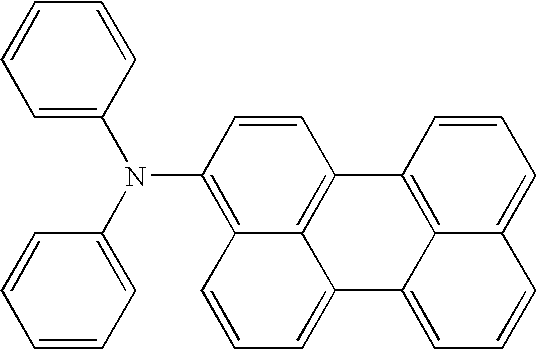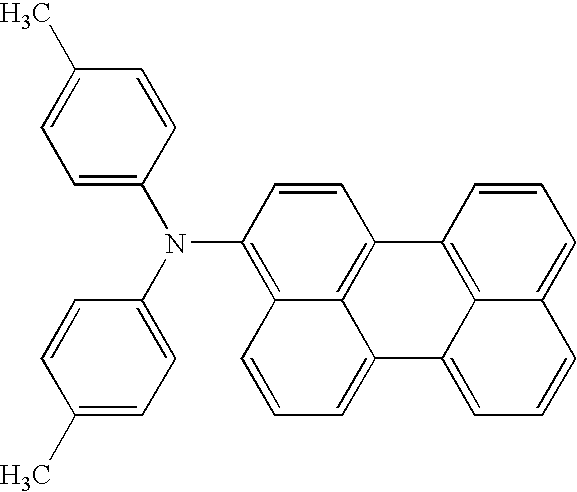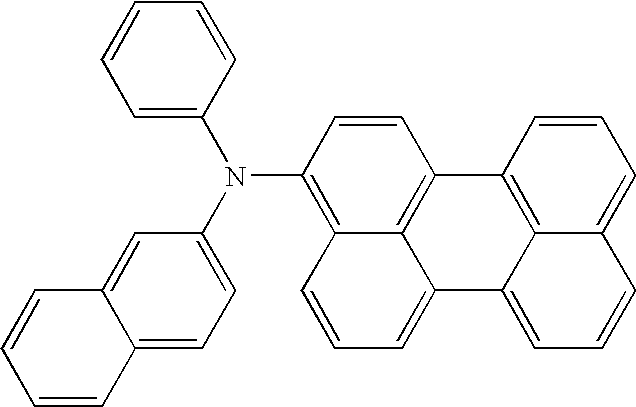Composition for organic electroluminescene element and organic electroluminescent using the same
a technology of organic electroluminescent and organic electroluminescent, which is applied in the direction of discharge tube luminescnet screen, natural mineral layered product, perylene derivative, etc., can solve the problems of low luminance and luminescence efficiency, short life, easy deterioration of properties, etc., to improve the stability of organic el device, prevent pin holes, and improve film forming properties
- Summary
- Abstract
- Description
- Claims
- Application Information
AI Technical Summary
Benefits of technology
Problems solved by technology
Method used
Image
Examples
example 2
[0096] N,N'-(3-Methylphenyl)-N,N'-diphenyl-1,1'-biphenyl-4,4'-diamine (TPD) and polyvinylcarbazole (PVK) were dissolved in 1,2-dichloroethane at a ratio of 1:1, and this solution was used to form a hole injection layer at a film thickness of 50 nm on a cleaned glass plate having an ITO electrode by a spin coating method. On the top of the hole injection layer thus obtained, Compound (C1) below: 187
[0097] and Compound (B42) in Table 2 were vapor-codeposited at a ratio of 95:5 to give an electron injection type light-emitting layer having a film thickness of 60 nm. On the top thereof, a magnesium and silver alloy (mixing ratio 10:1) was vapor-deposited to form an electrode having a film thickness of 100 nm, and an organic EL device (two layer type) was thus obtained.
[0098] This device gave a red luminescence with a luminance of 1300 (cd / m.sup.2) at a dc voltage of 5 V, a maximum luminance of 18000 (cd / m.sup.2), a luminescence efficiency of 1.7 (1 m / W), and a value of x in the CIE chro...
example 3
[0100] TPD and polyvinylcarbazole (PVK) were dissolved in 1,2-dichloroethane at a ratio of 1:1, and this solution was used to form a hole injection layer at a film thickness of 50 nm on a cleaned glass plate having an ITO electrode by a spin coating method. On the top of the hole injection layer thus obtained, Compound (C2) below: 188
[0101] and DCJTB (D1) having the structure below: 189
[0102] were vapor-codeposited at a ratio of 97:3 to give an electron injection type light-emitting layer having a film thickness of 60 nm. On the top thereof, a magnesium and silver alloy (mixing ratio 10:1) was vapor-deposited to form an electrode having a film thickness of 100 nm, and an organic EL device (two layer type) was thus obtained.
[0103] This device gave a red luminescence with a luminance of 500 (cd / m.sup.2) at a dc voltage of 5 V, a maximum luminance of 9200 (cd / m.sup.2), a luminescence efficiency of 1.3 (1 m / W), and x=0.64.
[0104] The peak wavelength of the fluorescence spectrum of a soli...
example 4
[0105] Compound (A22) in Table 1 and Compound (B10) in Table 2 were dissolved in methylene chloride at a ratio of 93:7, and this solution was used to form a hole injection type light-emitting layer at a film thickness of 50 nm on a cleaned glass plate having an ITO electrode by a spin coating method. On the top of the hole injection type light-emitting layer thus obtained, bis(2-methyl-8-hydroxyquinolinate)(1-naphthalate) gallium complex was vapor-deposited to give an electron injection layer having a film thickness of 40 nm, on the top thereof a magnesium and silver alloy (mixing ratio 10:1) was vapor-deposited to form an electrode having a film thickness of 100 nm, and an organic EL device (two layer type) was thus obtained.
[0106] This device gave a red luminescence with a luminance of 2200 (cd / m.sup.2) at a dc voltage of 5 V, a maximum luminance of 15600 (cd / m.sup.2), a luminescence efficiency of 2.3 (1 m / W), and x=0.61.
[0107] The peak wavelength of the fluorescence spectrum of a...
PUM
| Property | Measurement | Unit |
|---|---|---|
| peak wavelength | aaaaa | aaaaa |
| fluorescence spectrum peak wavelength | aaaaa | aaaaa |
| wavelength | aaaaa | aaaaa |
Abstract
Description
Claims
Application Information
 Login to View More
Login to View More - R&D
- Intellectual Property
- Life Sciences
- Materials
- Tech Scout
- Unparalleled Data Quality
- Higher Quality Content
- 60% Fewer Hallucinations
Browse by: Latest US Patents, China's latest patents, Technical Efficacy Thesaurus, Application Domain, Technology Topic, Popular Technical Reports.
© 2025 PatSnap. All rights reserved.Legal|Privacy policy|Modern Slavery Act Transparency Statement|Sitemap|About US| Contact US: help@patsnap.com



